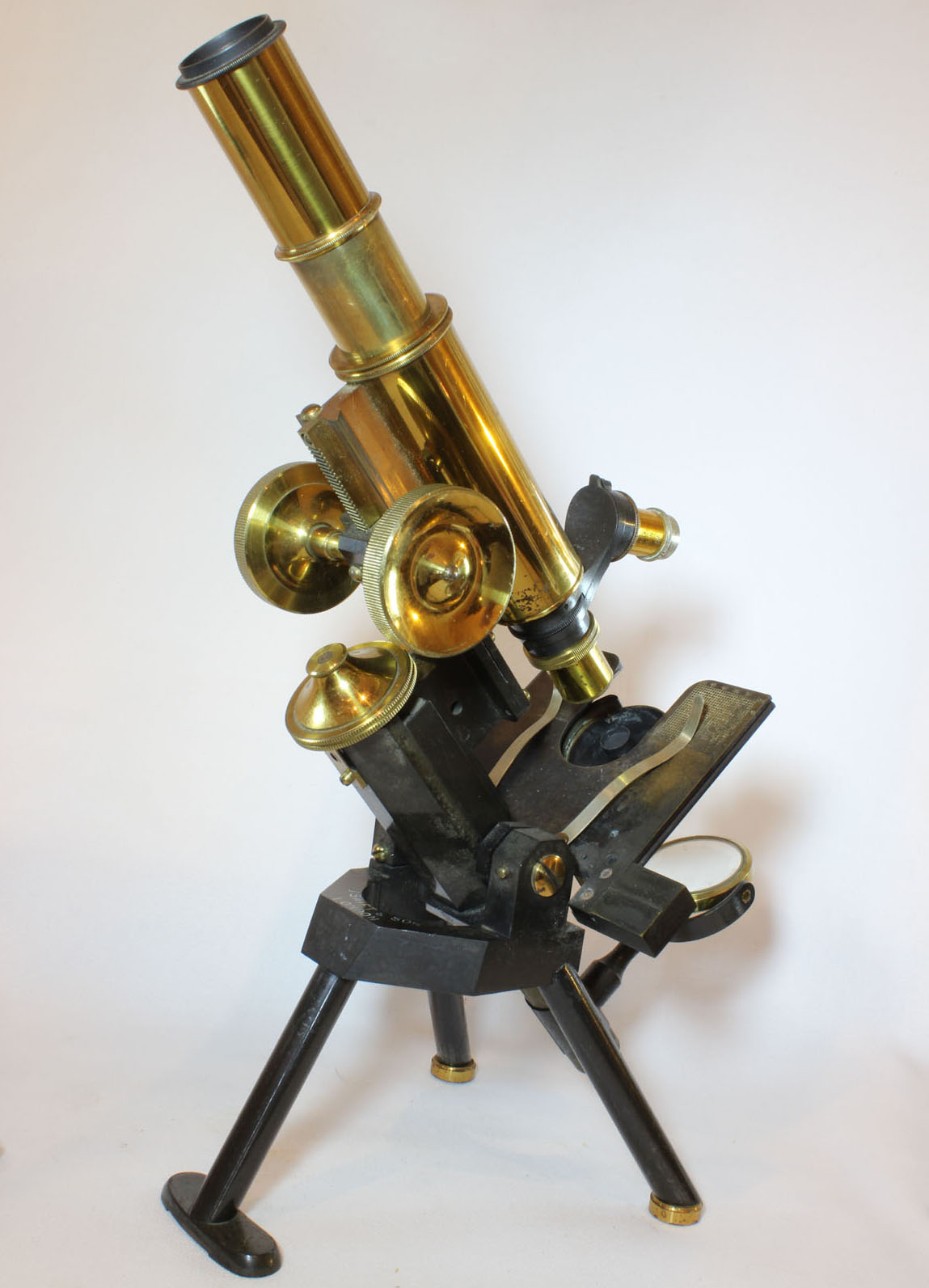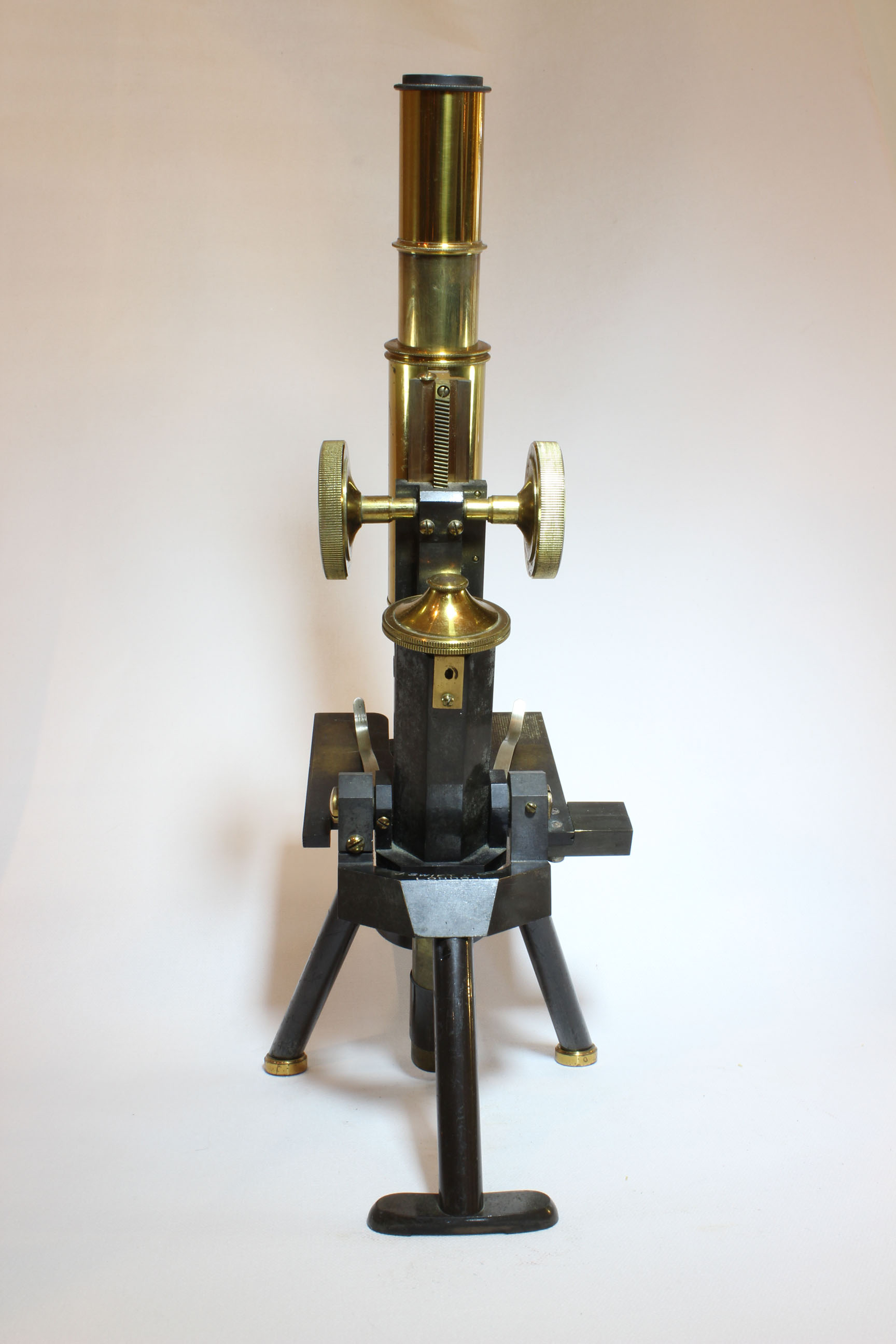MAKER: JAMES SWIFT & SON
MODEL: 'NEW HISTOLOGICAL AND PHYSIOLOGICAL MICROSCOPE'
c. 1895
SIGNED: J. SWIFT & SON, LONDON
SERIAL NUMBER: None
Please Click On Any Picture for a Larger Version
DESCRIPTION:
The microscope sits on a tripod which is a 'modified form of Powell and Lealand's'. This makes this stand particularly stable both for vertical and
horizontal work, the latter commonly used for photography in the years it was produced. Coarse focus is by a Swift-patented diagonal or 'spiral' Rack
and Pinion, and fine focus via a screw, controlled by a knob at the top of the limb in the continental style. It was claimed this screw focusing mechanism
was of 'entirely new construction' resulting in steady movement even at the highest powers. The large stage is U-shaped with a cutout on the front.
There is a circular collar to accept subtage apparatus; it was noted in the original publication in the Proceedings of the R.M.S. that it could also be
provided with a substage with 'universal adjustments for centering and focusing the illuminating apparatus.' The stage has two long clips.
There is a small extension on the right side of the rear of the stage to help accomodate an attachable mechanical stage (not present). There are grooves
on each side of the stage that could accomodate an optional sliding carrier. There is a stage grid with coordinates for easier location of a specific
location on any specific slide once that location had been previously noted. This grid is relatively unique and seldom, if ever, found on models other
than this one and the 'Discovery' Model. The grid is located more towards the front of the stage on the actual microscope, than is depicted in the
engraving, because it is the simpler modification used on the 'Discovery' model; the engraving next to the microscope in this collection shows a slightly
more complicated system in which there was also a second scale on the sliding stage carrier. A draw-tube (with no graduations) is present, this is also different than in the
engraving. A double nose piece is present as in the original engraving. Objectives are both by Swift, one is a 1 inch and the other a 2/3 inch.
The 1 inch was added to replace a second 2/3 inch by Watson that was attached to the microscope when it arrived to join this collection.
The eyepiece, original but unsigned, is labelled '2.' The gimballed substage mirror is double sided and planoconvex. The mirror mount slides up and down
on a tubular tailpiece, and can rotate right or left.
HISTORY OF THIS MICROSCOPE AND ITS SUCCESSOR, 'THE DISCOVERY'

 As shown in the Proceedings of the Royal Microscopical Society, series II, vol XIV, the microscope was announced in that Journal in 1894. The characteristics which seemed notable at the time included the features noted above including its 'entirely new' fine focus, its extreme stability, even in a horizontal position, and the large stage with cutout front. It was supplied with an understage collar (as in the present example) to accept substage accessories, but could also be supplied with an optional adjustable substage which could be adjusted in the vertical plane by rack and pinion, and also had a centering mechanism.
As shown in the Proceedings of the Royal Microscopical Society, series II, vol XIV, the microscope was announced in that Journal in 1894. The characteristics which seemed notable at the time included the features noted above including its 'entirely new' fine focus, its extreme stability, even in a horizontal position, and the large stage with cutout front. It was supplied with an understage collar (as in the present example) to accept substage accessories, but could also be supplied with an optional adjustable substage which could be adjusted in the vertical plane by rack and pinion, and also had a centering mechanism.


A portable version of this microscope was also made, with the main difference being four legs. with the rear two on a right-left swiveling mount to assure stability on an uneven surface, and also allowing them to turn 180 degrees, pointing upward which allowed the front legs to then swing backward, creating a much smaller footprint when folded this way, hence more portable. In order to fold that microscope:
1. The microscope is placed in the vertical position
2. The rear legs swivel right or left to point upward
3. The front legs are pulled back rotating on their hinge situated beneath and slightly to the rear of the inclination joint.
4. The stage folds upward.
That version was simply called the Portable Histological
or Portable Histological and Physiological
. In 2015 I became aware that the Portable Histological
microscope was also made in Aluminum and I would like to thank the owner for allowing me to include his images of an Aluminum example of the Portable Histological Microscope on another page so you can see it and compare to the tabletop brass version seen on this page. (The author would like to thank Allan Wissner for pointing out that this Aluminum version is a Portable version with folding legs unlike the tabletop example here).
In 1901, Scott undertook an antarctic expedition with the H.M.S. Discovery. Swift came out with a 'Discovery' microscope at about that time, claiming it was designed to be used on the voyage. The original 'New Histological and Physiological' microscope has subtle differences from the 'Discovery' Microscope.
Differences between this model and the 'Discovery' model, are the lack of a front opening in the stage (i.e. the stage of the Discovery was square, not U-shaped), and the attachement of the optical tube (arm) had a slightly curved shape rather than the right angled attachment arm of the New Histological; in addition, the pillar adjusted by the fine focus is polygonal on the model in this collection, while the Discovery model is round, resembling many continental-type microscopes. With one exception, the base of the rear foot, the tripod is the same on
both models, as is the substage, stage grid, mirror, tailpiece, and double nosepiece.
My example of the New Histological has the newer T-shaped rear foot, as found on the Discovery Microscope. Another option offered for the Discovery model was substitution of a Oberhauser-type horseshoe foot instead of the tripod. The engraving and image below on the left are examples of the Discovery microscope, the image of an actual example of the instrument (formerly in my own collection). The picture on the right is the "New Histological and Physiological" shown for
comparison.















